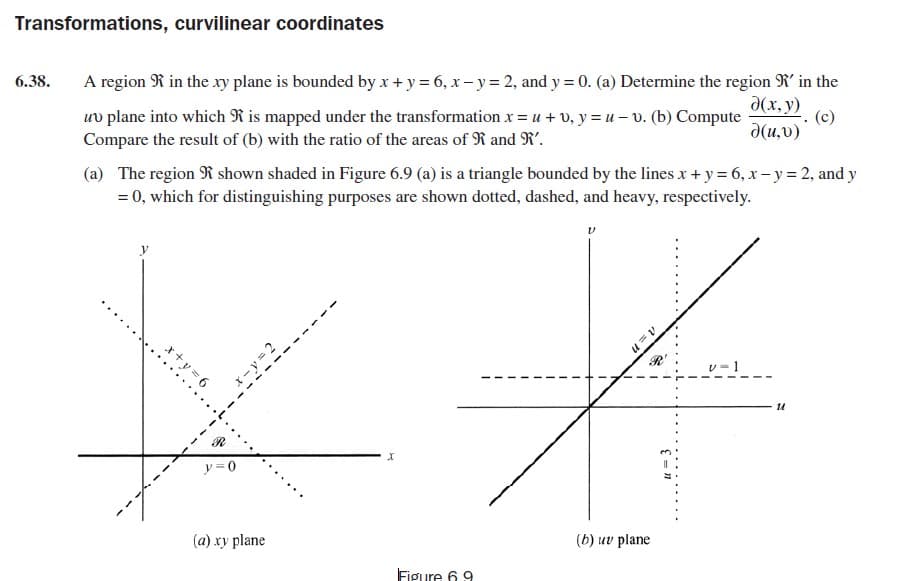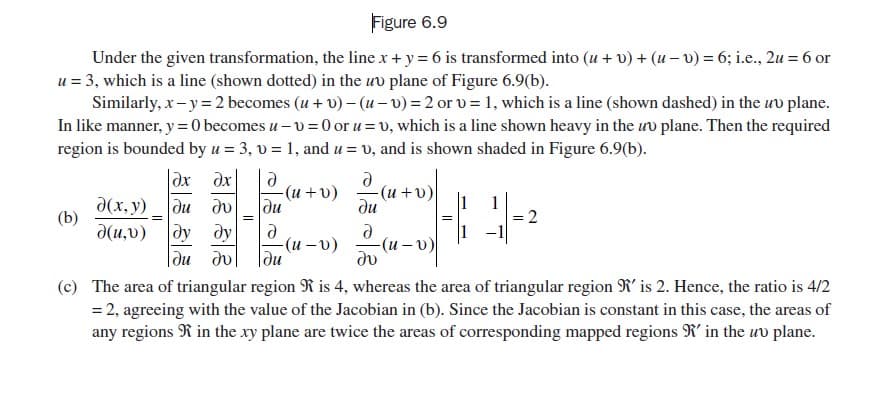A region R in the xy plane is bounded by x+y = 6, x- y = 2, and y = 0. (a) Determine the region R' in the a(x, y) a(u,v) 6.38. uv plane into which R is mapped under the transformation x = u + v, y = u – v. (b) Compute (a) The region R shown shaded in Figure 6.9 (a) is a triangle bounded by the lines x + y = 6, x - y = 2, and y = 0, which for distinguishing purposes are shown dotted, dashed, and heavy, respectively. Compare the result of (b) with the ratio of the areas of R and R'. R' x+y = 6 y = 0 (b) uv plane (a) xy plane E = n
A region R in the xy plane is bounded by x+y = 6, x- y = 2, and y = 0. (a) Determine the region R' in the a(x, y) a(u,v) 6.38. uv plane into which R is mapped under the transformation x = u + v, y = u – v. (b) Compute (a) The region R shown shaded in Figure 6.9 (a) is a triangle bounded by the lines x + y = 6, x - y = 2, and y = 0, which for distinguishing purposes are shown dotted, dashed, and heavy, respectively. Compare the result of (b) with the ratio of the areas of R and R'. R' x+y = 6 y = 0 (b) uv plane (a) xy plane E = n
Advanced Engineering Mathematics
10th Edition
ISBN:9780470458365
Author:Erwin Kreyszig
Publisher:Erwin Kreyszig
Chapter2: Second-order Linear Odes
Section: Chapter Questions
Problem 1RQ
Related questions
Concept explainers
Equations and Inequations
Equations and inequalities describe the relationship between two mathematical expressions.
Linear Functions
A linear function can just be a constant, or it can be the constant multiplied with the variable like x or y. If the variables are of the form, x2, x1/2 or y2 it is not linear. The exponent over the variables should always be 1.
Question
6.38) my professor says I have to explain the steps in the solved problems in the picture. Not just copy eveything down from the text.

Transcribed Image Text:Transformations, curvilinear coordinates
A region R in the xy plane is bounded by x+ y = 6, x – y = 2, and y = 0. (a) Determine the region R' in the
a(x, y)
6.38.
uv plane into which R is mapped under the transformation x = u + v, y = u – v. (b) Compute
Compare the result of (b) with the ratio of the areas of R and R'.
(c)
a(u,v)
(a) The region R shown shaded in Figure 6.9 (a) is a triangle bounded by the lines x + y = 6, x – y = 2, and y
= 0, which for distinguishing purposes are shown dotted, dashed, and heavy, respectively.
R'
x+y = 6
y = 0
(b) uv plane
(a) xy plane
Figure 6 9

Transcribed Image Text:Figure 6.9
Under the given transformation, the line x + y = 6 is transformed into (u + v) + (u – v) = 6; i.e., 2u = 6 or
u = 3, which is a line (shown dotted) in the uv plane of Figure 6.9(b).
Similarly, x- y = 2 becomes (u + v) – (u – v) = 2 or v = 1, which is a line (shown dashed) in the uv plane.
In like manner, y =0 becomes u – v=0 or u=v, which is a line shown heavy in the uv plane. Then the required
region is bounded by u = 3, v = 1, and u = v, and is shown shaded in Figure 6.9(b).
Ox dx
a(x, y) du dv
du
(u +v)
ди
(b)
a(u,v)
:2
|ду ду
-(и — 0)
-(и — v)
|du dul
|du
(c) The area of triangular region R is 4, whereas the area of triangular region R’is 2. Hence, the ratio is 4/2
= 2, agreeing with the value of the Jacobian in (b). Since the Jacobian is constant in this case, the areas of
any regions R in the xy plane are twice the areas of corresponding mapped regions R' in the uv plane.
Expert Solution
This question has been solved!
Explore an expertly crafted, step-by-step solution for a thorough understanding of key concepts.
Step by step
Solved in 2 steps with 2 images

Knowledge Booster
Learn more about
Need a deep-dive on the concept behind this application? Look no further. Learn more about this topic, advanced-math and related others by exploring similar questions and additional content below.Recommended textbooks for you

Advanced Engineering Mathematics
Advanced Math
ISBN:
9780470458365
Author:
Erwin Kreyszig
Publisher:
Wiley, John & Sons, Incorporated

Numerical Methods for Engineers
Advanced Math
ISBN:
9780073397924
Author:
Steven C. Chapra Dr., Raymond P. Canale
Publisher:
McGraw-Hill Education

Introductory Mathematics for Engineering Applicat…
Advanced Math
ISBN:
9781118141809
Author:
Nathan Klingbeil
Publisher:
WILEY

Advanced Engineering Mathematics
Advanced Math
ISBN:
9780470458365
Author:
Erwin Kreyszig
Publisher:
Wiley, John & Sons, Incorporated

Numerical Methods for Engineers
Advanced Math
ISBN:
9780073397924
Author:
Steven C. Chapra Dr., Raymond P. Canale
Publisher:
McGraw-Hill Education

Introductory Mathematics for Engineering Applicat…
Advanced Math
ISBN:
9781118141809
Author:
Nathan Klingbeil
Publisher:
WILEY

Mathematics For Machine Technology
Advanced Math
ISBN:
9781337798310
Author:
Peterson, John.
Publisher:
Cengage Learning,

